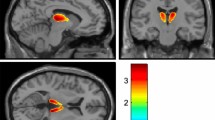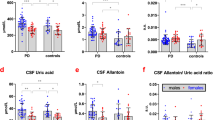Abstract
IN clinical cases of Parkinsonism there is a decrease in the concentration of dopamine in the caudate nucleus and putamen and of noradrenaline and 5-hydroxytryptamine (5-HT) throughout the brain1,2. This is very interesting in view of the fact that these amines are supposed to be transmitters in the monoaminergic nervous system3. Substances known to decrease the transmission from the monoaminergic neurones, for example, reserpine and chlorpromazine, are also known to cause symptoms of Parkinsonism in both animals and humans. Dopamine is transformed by monoamine-oxidase (MAO) to dihydroxyphenylacetic acid and further by catechol-O-methyl-transferase to homovanillic acid (HVA). 5-HT is transformed by MAO to 5-hydroxyindoleacetic acid (5-HIAA). These two acids, but not the corresponding amines, can be determined in cerebrospinal fluid (CSF); the concentration of the acids in CSF is closely related to that in brain4. In Parkinson's disease there is a tendency to low values in CSF of both HVA and 5-HIAA5.
This is a preview of subscription content, access via your institution
Access options
Subscribe to this journal
Receive 51 print issues and online access
$199.00 per year
only $3.90 per issue
Buy this article
- Purchase on Springer Link
- Instant access to full article PDF
Prices may be subject to local taxes which are calculated during checkout
Similar content being viewed by others
References
Bernheimer, H., Birkmayer, W., and Hornykiewicz, O., Klin. Wschr., 39, 1056 (1961).
Ehringer, H., and Hornykiewicz, O., Klin. Wschr., 38, 1236 (1960).
Carlsson, A., Falck, B., and Hillarp, N. Å., Acta Physiol. Scand., 56, Suppl. 196 (1962).
Andersson, H., and Roos, B.-E., Acta Pharmacol. Toxicol. (in the press).
Johansson, B., and Roos, B.-E., Life Sci., 6, 1449 (1967).
Despopulos, A., and Weissbach, H., Amer. J. Physiol., 189, 548 (1957).
Werdinius, B., Acta Pharmacol. et Toxicol., 25, 9 (1967).
Guldberg, H. C., Ashcroft, G. W., and Crawford, T. B. B., Life Sci., 5, 1571 (1966).
Neff, N. H., Tozer, T. N., and Brodie, B. B., J. Pharm. Exp. Ther., 158, 214 (1967).
Werdinius, B., Acta Pharmacol. et Toxicol., 25, 18 (1967).
Roos, B.-E., Andén, N. E., and Werdinius, B., Intern. J. Neuropharmacol., 3, 117 (1964).
Andén, N. E., Roos, B.-E., and Werdinius, B., Life Sci., 2, 448 (1963).
Ashcroft, G. W., and Sharman, D., Nature, 186, 1050 (1960).
Author information
Authors and Affiliations
Rights and permissions
About this article
Cite this article
OLSSON, R., ROOS, BE. Concentrations of 5-Hydroxyindole-acetic Acid and Homovanillic Acid in the Cerebrospinal Fluid after Treatment with Probenecid in Patients with Parkinson's Disease. Nature 219, 502–503 (1968). https://doi.org/10.1038/219502a0
Received:
Issue Date:
DOI: https://doi.org/10.1038/219502a0
This article is cited by
-
CNS tryptamine metabolism in hepatic coma
Journal of Neural Transmission (1980)
-
Quantitation of CSF concentrations and biological activity of probenecid metabolites
European Journal of Clinical Pharmacology (1980)
-
Cerebrospinal fluid cyclic AMP and acid monoamine metabolites following probenecid: Studies in psychiatric patients
Psychopharmacology (1979)
-
Tardive dyskinesia: A clinical test of the supersensitivity hypothesis
Psychopharmacology (1979)
-
Probenecid-induced increase of 5-hydroxytryptamine synthesis in rat brain, as measured by formation of 5-hydroxytryptophan
Psychopharmacology (1979)
Comments
By submitting a comment you agree to abide by our Terms and Community Guidelines. If you find something abusive or that does not comply with our terms or guidelines please flag it as inappropriate.



